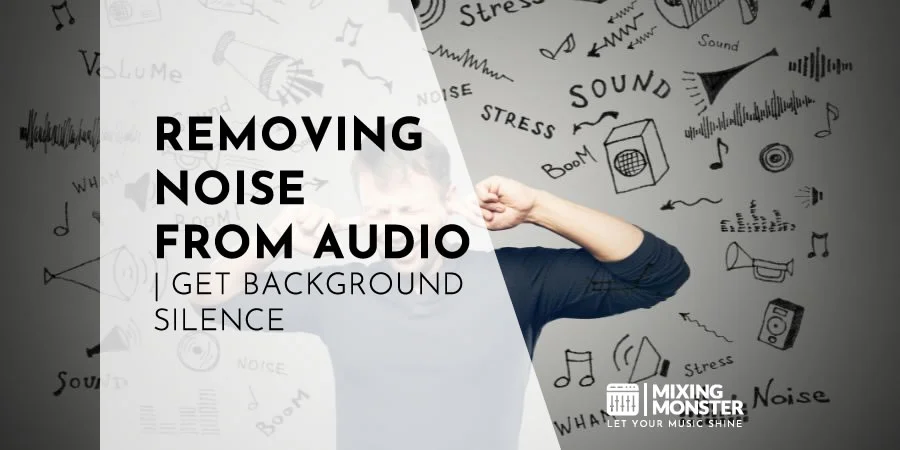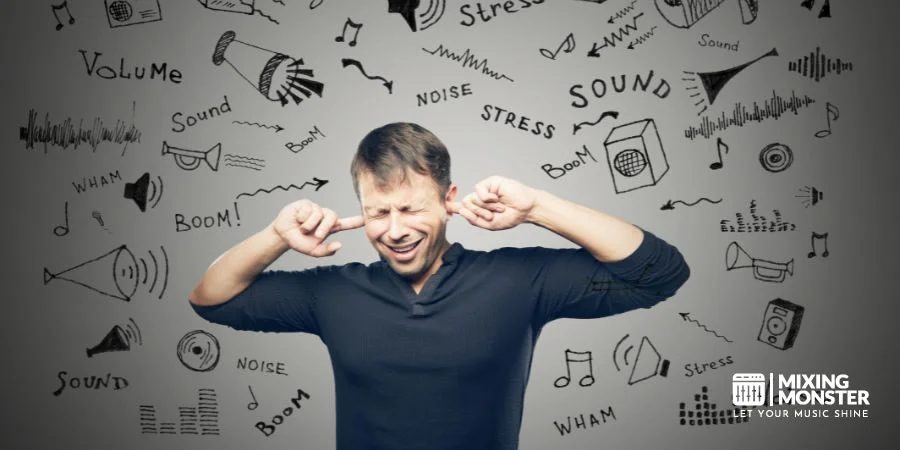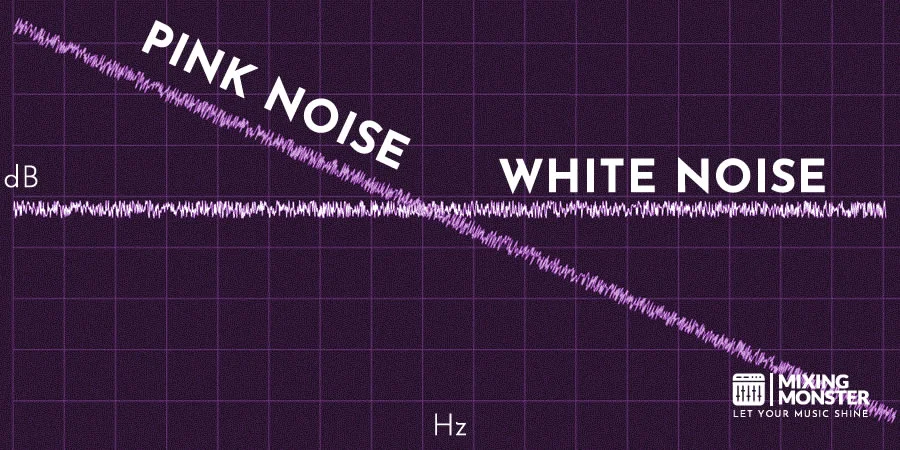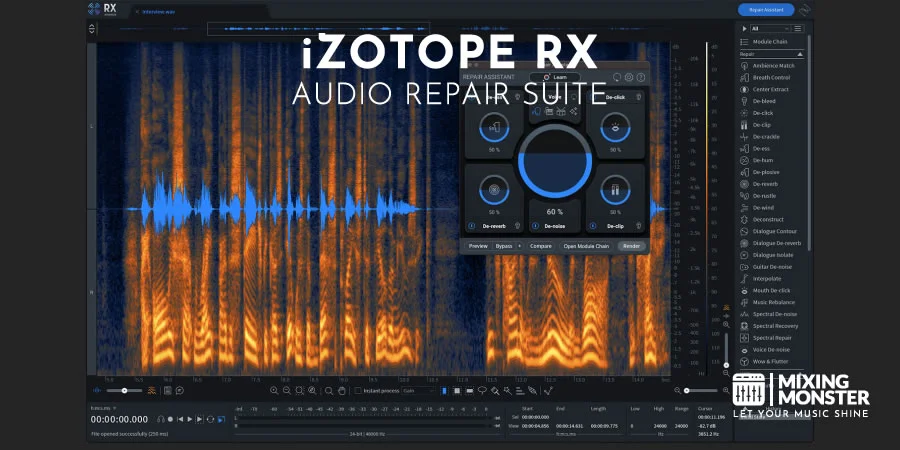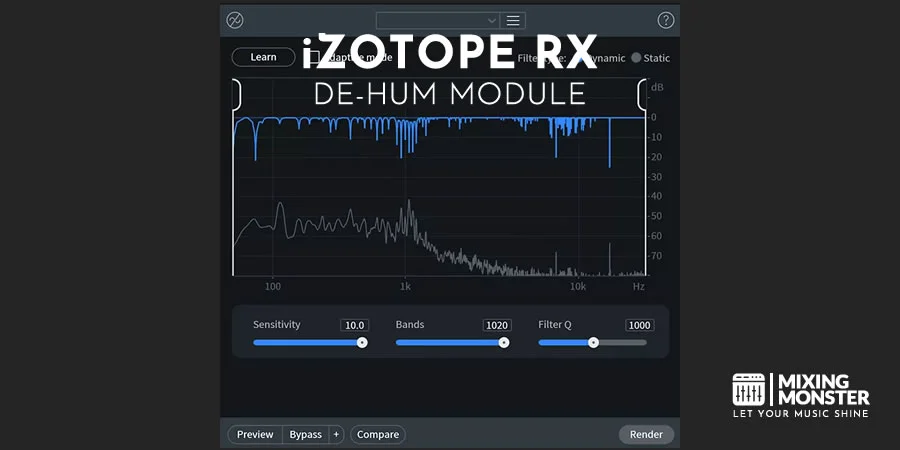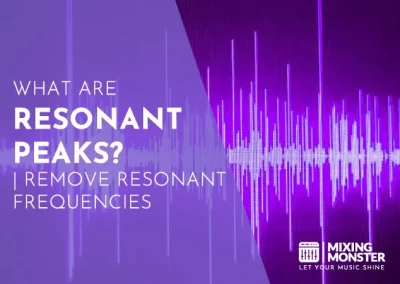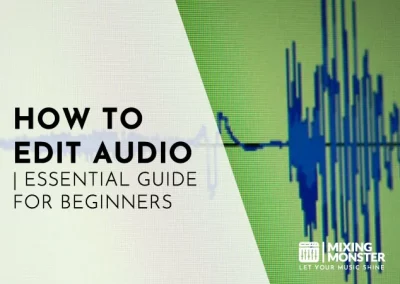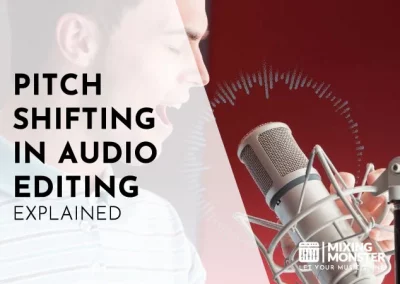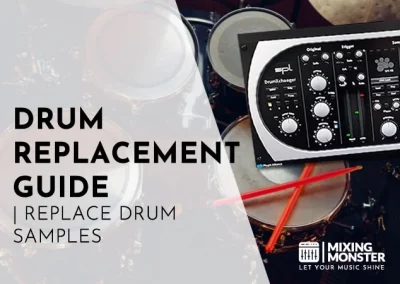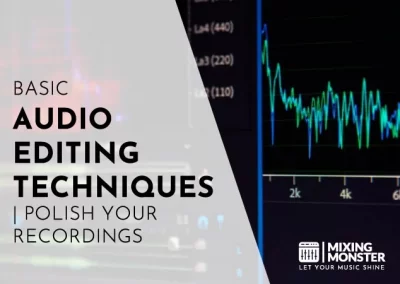Home > Blog > Editing > Editing Techniques
Affiliate Disclaimer: We may earn a commission if you purchase through our links
In an era where crystal-clear audio is not just desired but expected, mastering the task of removing unwanted noise from audio has become essential. Whether you’re a musician striving for perfection, a podcaster seeking clarity, or anyone in between, the journey to pristine sound often leads to one destination: background silence.
Removing noise from audio represents techniques for achieving clean sound quality in suboptimal audio recordings. Advanced tools and methods offer capabilities for identifying and eliminating unwanted background noise in audio recordings while isolating and enhancing desired audio elements.
This article explores innovative noise removal software, hardware options, and online services tailored for musicians, streamers, journalists, and transcribers. Say goodbye to crowded and noisy audio recordings and discover how to achieve clean and transparent audio quality!
Table Of Contents
1. The Importance Of Removing Noise From Audio
2. Understanding Noise In Audio
3. Techniques For Removing Noise From Audio
4. Step-By-Step Guide: Removing Noise From Audio
5. Who Benefits From Noise Removal?
6. Deep Dive: How Noise Removal Software Works
7. The Benefits And Limitations Of Noise Removal
8. The Impact Of AI On Noise Removal
9. The Sound Of Silence: Achieve Clean Recordings
10. FAQ

1. The Importance Of Removing Noise From Audio
What Is Noise In Audio Recordings?
Noise in audio recordings is an unwelcome intruder, a mixture of unwanted sounds that infiltrate and disturb the clarity of your main audio. It’s like the rustle of leaves on a quiet day or the distant hum of traffic disrupting a serene moment.
In the context of audio work, these noises can come from the electrical buzz, ambient room sound, equipment hiss, or even the subtle breath of the performer. They’re not part of the story you’re trying to tell with your audio, and they can significantly diminish the listener’s experience.
The Importance Of Clear Audio In Music Production
Imagine listening to your favorite song, but instead of the clear, crisp vocals and the sharp, resonant instruments, a hiss overlaps the track or a hum that distracts from the melody.
In music production, such distractions are more than nuisances; they can break the emotional connection between the artist and the listener. Clear audio is vital—it allows the true essence of the music to shine through, delivering the emotional impact and the nuanced performance intended by the artists.
It’s not just about removing what’s unwanted; it’s about preserving and enhancing what is.
Audio Noise Removal Overview
Removing noise from audio is both an art and a science. It’s about understanding the nature of the noise—its source, its characteristics, and how it interacts with the desired audio.
Then, it’s about applying the right tools and techniques to reduce or eliminate that noise without harming the underlying sound. This can involve hardware solutions like noise gates or software solutions, each with approaches and algorithms designed to target specific types of noise.
The goal is always the same: to bring forth the best possible audio quality, making it as clean and clear as it was meant to be heard.
2. Understanding Noise In Audio
How Does Noise Arise In Audio Recordings?
Noise can sneak into your recordings in numerous ways. It might be the ambient sound of the room, the air conditioner, or outside traffic. It could be electrical interference from nearby equipment or the inherent noise floor of your recording device.
Sometimes, it results from poor microphone placement or low-quality cables and equipment. Understanding these sources is crucial because each type of noise might require a different approach to remove effectively.
Identifying Common Audio Noise Types
Let’s break down some of the noise culprits:
- White Noise:
This constant, static sound covers all frequencies. It’s akin to the sound of a TV set tuned to a dead channel. - Pink Noise:
Less harsh than white noise, pink noise has more energy at lower frequencies and is often present in electronic devices. - Environmental Noises:
These are the sounds from your surroundings, like traffic, air conditioning, or people talking in the next room.
By identifying the type of noise, you can tailor your noise removal strategy to be more effective.
The Impact Of Noise On Audio Recordings
Noise can turn a potential masterpiece into a cluttered mess. It masks the details, reduces the dynamic range, and can make recordings sound amateurish.
For professionals, it can mean the difference between a commercially viable product and one that’s not. It can mean the difference between an immersive experience and a distraction for listeners.
That’s why understanding and combating noise is so crucial in music production.
3. Techniques For Removing Noise From Audio
Traditional vs. Modern Noise Removing Approaches
In the past, removing noise from audio was a daunting task, often requiring expensive hardware and a lot of technical know-how.
Traditional methods included analog hardware like noise gates and notch filters to suppress unwanted sounds. While effective to a degree, they were limited in their precision and could sometimes affect the quality of the desired audio.
Fast forward to today, and modern digital technology has revolutionized this process. Software solutions now offer sophisticated algorithms that intelligently differentiate between noise and the audio you want to keep, often with just a few clicks.
Noise Removing Software Solutions Explored
Modern noise removal software provides various tools to tackle multiple types of noise. These tools analyze the audio, identify noise patterns, and subtract them from the recording. Some popular software includes:
- Audacity:
A free, open-source option great for basic noise reduction. - Adobe Audition:
Known for its comprehensive tools and spectral editing capabilities. - Izotope RX Suite:
A professional-grade suite renowned for its advanced algorithms and detailed control.
In-Depth Look At Izotope RX Suite
Izotope RX is a powerhouse when it comes to cleaning up audio. It offers tools that tackle everything from background noise and hums to clicks and unwanted reverb.
Its spectral repair tool allows you to visually identify and isolate noise elements, removing them without affecting the audio you want to keep. The software can initially seem daunting with its myriad controls, but it’s incredibly effective once mastered.
Noise Removing Hardware Innovations
While software is often the go-to for noise removal, hardware has yet to be left behind. Tools like noise gates and dynamic processors are essential in many professional setups.
A noise gate allows sound above a set threshold to pass while blocking anything below, effectively cutting out lower-level background noise. Meanwhile, dynamic processors can automatically adjust volume levels to minimize the impact of sudden noise bursts.
Understanding Noise Gates
A noise gate is beneficial in live settings or during the initial recording phase. It’s all about setting the suitable threshold: too low, and you won’t block enough noise; too high, and you might cut off the audio you want to keep.
It requires a bit of tweaking and an excellent ear to set up correctly, but it can significantly reduce the need for post-production noise removal.
Discover Noise Removing Online Services
In addition to standalone software, several online services can clean up your audio with minimal fuss. These services often use AI and machine learning algorithms to analyze and process your files.
Lalal.ai, for example, offers a straightforward interface where you upload your audio, and the service does the rest, separating vocals from instruments and removing noise. It’s a quick and easy option, especially for those without technical audio editing skills.
Features And Benefits Of Lalal.ai
| Feature | Description | Benefit |
| AI-Powered Technology | Utilizes advanced AI algorithms for noise removal and sound isolation. | Provides precise and intelligent noise removal, leading to higher-quality audio. |
| User-Friendly Interface | Simple and intuitive web-based interface. | Easy for users of all skill levels to navigate and use effectively. |
| Fast Processing | Quick analysis and processing of audio files. | It saves time, allowing for rapid improvement and the use of audio. |
| High-Quality Output | Produces clean, clear audio with minimal distortion. | Ensures professional-sounding results suitable for various applications. |
| Music Source Separation | Capable of isolating vocals and instruments in music tracks. | Useful for musicians and producers looking to remix or remaster tracks. |
| Various File Format Support | Accepts a wide range of audio file formats. | Accommodates users’ needs, making it versatile and convenient. |
| No Software Installation | Web-based service that doesn’t require any software download or setup. | Accessible and convenient, with no need for additional system resources. |
| Affordable Pricing | Competitive pricing with different options based on user needs. | Offers cost-effective solutions for high-quality noise removal |
4. Step-By-Step Guide: How To Remove Noise From Audio
Preparing Your Audio File
Before you start the noise removal process:
- Ensure your audio file is in a suitable format and quality.
- If converting from another format, aim for minimal compression to preserve as much detail as possible.
- Listen to the entire recording to identify all the areas with noise and note any sections that might need special attention.
Selecting The Right Noise Removal Tools
Choosing the right tool depends on the noise type and the audio’s complexity. A beginner tool like Audacity’s noise reduction feature might suffice for simple, consistent background noise.
For more complex or varying noise, or if you need to preserve high-quality audio, a more advanced tool like Izotope RX containing noise removal models for specific purposes might be necessary.
Applying Noise Reduction Techniques
Once you’ve chosen your tool, the general process usually involves selecting a portion of the audio where only the noise is present. This “noise profile” helps the software understand what to remove from the rest of the recording.
After applying the noise reduction, listen carefully to the results. You should adjust the settings and try a few times to find the right balance between noise removal and preserving the quality of your audio.
Finalizing Your Clean Audio
After removing the noise, listen to your audio in different environments (using headphones, speakers, etc.) to ensure it sounds good everywhere.
Consider making further adjustments with equalization or compression to perfect the sound. Once satisfied, save your cleaned audio in a high-quality format for its final use.
Essential Steps For Removing Noise From Audio
- Prepare Your Audio File:
Ensure it’s in a suitable format and assess the recording for noise types and locations. - Select The Right Tools:
Choose noise removal software or hardware based on the noise type and desired quality. - Create A Noise Profile:
Use a segment of the audio where only the unwanted noise is present to help the software identify what to remove. - Apply Noise Reduction:
Use the selected tool to reduce or remove the noise, adjusting settings for the best result. - Listen And Adjust:
Carefully review the cleaned audio, making further adjustments to the settings if necessary. - Finalize The Audio:
Once satisfied, save the cleaned audio in a high-quality format suitable for its final use.

5. Who Benefits From Noise Removal?
Musicians: Seeking Sonic Perfection
For musicians, noise removal is not just about clarity but integrity. It’s about ensuring that every strum, every vocal nuance, and every beat is heard precisely as intended.
Removing background noise from recordings allows the true essence of the music to shine through, providing listeners with an unadulterated auditory experience.
Whether for a demo track, an album, or live performance recordings, noise removal can significantly enhance the quality and impact of the music.
Streamers: Ensuring Clear Communication
In streaming, audio quality can make or break an audience’s engagement. Streamers rely on clear audio to communicate effectively with their viewers. Background noise, from the hum of a computer fan to outside traffic, can be distracting and give a sense of unprofessionalism.
Streamers can deliver a more polished and enjoyable experience by employing noise removal techniques (like customized noise gates), keeping viewers focused on the content rather than the noise.
Journalists: Crafting Clear Stories
Background noise is an unavoidable challenge for journalists, especially those in the field. Whether it’s an interview in a bustling café or a report from a windy street, noise can obscure the critical information and detract from the story’s impact.
Noise removal tools enable journalists to present their stories with clarity, ensuring that the audience hears every word and the authentic atmosphere of the scene is preserved.
Transcribers: Guaranteeing Accuracy
Transcribers convert audio into written text, a process where clarity is paramount. Background noise makes their job more complex and can lead to inaccuracies in the transcription.
These inaccuracies can significantly affect legal, medical, or media professionals. Noise removal helps ensure that transcribers can hear the audio clearly, resulting in more accurate and reliable transcriptions.
6. Deep Dive: How Noise Removal Software Works
The Process: Analyzing And Removing Noise
Noise removal software analyzes the audio to identify the difference between noise and the desired sound. It looks at the audio spectrum and recognizes patterns representing noise, often allowing the user to select a noise sample.
Using this ‘noise profile,’ the software then goes through the rest of the audio, subtracting the noise from the waveform without affecting the underlying sound.
This process requires sophisticated algorithms to ensure that the removal is as clean as possible, preserving the quality and integrity of the original audio.
Music Source Separation And Stem Extraction
Some advanced noise removal tools go further with music source separation and stem extraction. This means they can isolate individual elements of a piece of music, like the vocals, guitar, drums, etc., and then remove noise from these elements separately.
This is particularly useful in remixing and restoration, where you might only have access to a mixed track but want to clean up or alter individual parts of the recording.
Focus: Isolating The Desired Audio
The ultimate goal of noise removal is to eliminate unwanted sounds and isolate and enhance the audio you want to keep. This requires a balance — remove too little noise, and the recording will still sound dirty; remove too much, and you risk losing vital parts of the audio.
It’s a delicate process that often involves a bit of trial and error, fine-tuning settings, and sometimes even going through the audio manually to address specific issues.
7. The Benefits And Limitations Of Noise Removal
Achieving Audio Clarity: The Realistic Picture
Noise removal can dramatically improve the clarity and quality of audio recordings. For professionals, this means delivering a product that meets high standards and enjoying clearer, more enjoyable sound for general users.
Music can enhance the listening experience by revealing subtle details and nuances. Videos, podcasts, and broadcasts ensure the message is conveyed clearly, without distraction. In transcription and analysis, it provides accuracy and ease of understanding.
However, it’s essential to recognize that noise removal is not a magic wand. While modern tools are incredibly sophisticated, they have their limitations.
Extreme noise, varying noise types, and noises that closely resemble the desired audio can be challenging to remove altogether without affecting the quality of the underlying sound.
Understanding these limitations helps set realistic expectations and guides users toward the best possible outcome with the tools.
Recognizing The Boundaries Of Noise Removing
Noise removal works best when the noise is consistent and distinct from the desired audio. It’s more challenging when the noise varies significantly throughout the recording or is similar in frequency and amplitude to the sounds you want to keep.
Some noise may remain in these cases, or some desired audio might be inadvertently removed or altered. The key is to find the right balance and use the tools judiciously, sometimes accepting a slight imperfection to preserve the audio’s overall integrity.
8. The Impact Of AI On Noise Removal
Transforming Noise Removal With AI
Artificial Intelligence (AI) is revolutionizing the noise removal field, offering more intuitive, efficient, and practical tools than ever before.
AI algorithms can analyze audio with incredible speed and precision, learning from vast datasets to distinguish between noise and desired sound more accurately. They adapt to different types of noise, even within the same recording, and can often provide cleaner results with less user intervention.
AI doesn’t just remove noise; it understands it. It can recognize the characteristics of different noises and treat them appropriately, applying more aggressive noise reduction where it’s needed and preserving the integrity of the audio where it’s not.
This results in a cleaner, more natural-sounding output, often with less effort and time required from the user.
Personalization And Precision: AI’s Custom Touch
One of the most exciting aspects of AI in noise removal is its ability to personalize the process. AI can learn from user feedback, adjusting its approach to fit the specific preferences and needs of the individual.
It can also analyze the particular characteristics of the audio it’s working with, tailoring its noise removal strategies to the unique context of each recording.
We can expect even more advanced and intuitive noise-removal tools as AI evolves. These will not only make the process easier and more accessible for everyone but also open up new possibilities for audio enhancement and restoration that we’ve only just begun to explore.
9. The Sound Of Silence: Achieve Clean Recordings
Recap Of Strategies For Removing Noise From Audio
As we’ve explored, removing noise from audio enhances clarity, ensuring that the listener focuses on the intended sound. Techniques vary from traditional hardware like noise gates to sophisticated software solutions offering spectral editing and AI-powered enhancements.
Remember, the key to effective noise removal is understanding the nature of the noise and choosing the right tool for the job.
Embrace The Quiet: Achieve Clean Recordings
Achieving clean recordings isn’t just about removing the unwanted; it’s about embracing the sound of silence. This silence isn’t merely the absence of noise; it’s the presence of potential – the pristine backdrop against which your audio can truly shine.
By effectively removing noise, you allow every detail, every nuance, and every emotion in your recordings to be heard as intended. Whether you’re a musician, a podcaster, a journalist, or anyone else working with audio, mastering the art of noise removal is a step towards achieving perfection in your craft.
Happy noise removal!
10. FAQ
- What Is Noise Removal And Why Is It Important?
Noise removal is the process of eliminating unwanted sounds from audio recordings. Improving clarity, ensuring the focus remains on the intended audio, and providing a professional-quality listening experience are crucial. - How Does Software Like Izotope RX Work?
Izotope RX works by analyzing the audio to identify and isolate the noise. Using advanced algorithms, it can then remove or reduce the noise while preserving the quality of the underlying audio. Features like spectral editing provide a visual and intuitive way to clean up recordings. - Can All Types Of Noise Be Removed?
While many types of noise can be significantly reduced or completely removed, some complex noises or noises that closely resemble the desired audio can be challenging to eliminate entirely. The effectiveness of noise removal often depends on the nature of the noise and the tools used. - What Are The Limitations Of Current Noise Removal Technologies?
Current technologies struggle with extremely varied or dynamic noises and can sometimes affect the desired audio quality if not used carefully. The user’s skill and the recording’s quality also play a role in the effectiveness of noise removal. - How Will AI Shape The Future Of Noise Removal?
AI is set to make noise removal more intuitive, effective, and accessible. It offers the potential for personalized and adaptive noise removal strategies, learning from the user and the audio to provide the best possible results.

